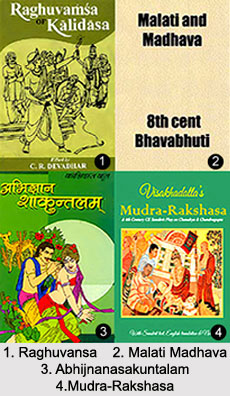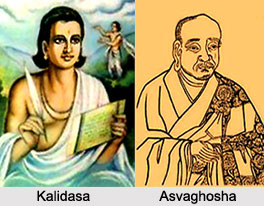 Ancient dramas occupy an important place in the Sanskrit Literature. Some of the Sanskrit dramas of ancient period have been considered as finest pieces of literature. These dramas had been written not only as literary creation but also for enactment on the stage. India has a long tradition of theatrical art with a number of works on dramaturgy. The Natyashastra of Bharata for example is a treatise on dramatic art. It offers rules for every aspect of dramatic performance, including the construction of stage. From time immemorial drama has been a very popular form of entertainment. It has been a popular form of entertainment on particular occasions. Scores of reputed poets and writers wrote a number of dramas in different periods of Indian history. Asvaghosa, Bhasa, Kalidasa, Visakhadatta, Sudraka, Sri Harsa Dandin Rajasekhara, Bhavabhuti, Murari, Bhatta Narayana, Harshavardhana etc. are some of them, whose dramatic works have been considered of high literary merit. Sanskrit dramas have an indigenous origin and experienced gradual evolution.
Ancient dramas occupy an important place in the Sanskrit Literature. Some of the Sanskrit dramas of ancient period have been considered as finest pieces of literature. These dramas had been written not only as literary creation but also for enactment on the stage. India has a long tradition of theatrical art with a number of works on dramaturgy. The Natyashastra of Bharata for example is a treatise on dramatic art. It offers rules for every aspect of dramatic performance, including the construction of stage. From time immemorial drama has been a very popular form of entertainment. It has been a popular form of entertainment on particular occasions. Scores of reputed poets and writers wrote a number of dramas in different periods of Indian history. Asvaghosa, Bhasa, Kalidasa, Visakhadatta, Sudraka, Sri Harsa Dandin Rajasekhara, Bhavabhuti, Murari, Bhatta Narayana, Harshavardhana etc. are some of them, whose dramatic works have been considered of high literary merit. Sanskrit dramas have an indigenous origin and experienced gradual evolution.
Kalidasa
Kalidasa is historically known to be the greatest Litterateur of India`s national heritage. The composure of his artistic attainment has garnered him an elevated position amongst other world poets. Kalidasa has continued to portray his relevancy through the centuries.. Kalidasa continues to beam throughout the world as one of the greatest exponents of Indian Sanskritic culture. Important works of Kalidasa includes Ritusamhara, Abhijnanasakuntalam, Raghuvansa, Kumarasambhava, Malavikagnimitra and others.
Bhasa
Bhasa was known for the allusions in the works of other Sanskrit dramatists until the texts of 13 of his dramas were discovered and published in 1912. Most of his works are adaptations of theme of heroism and romantic love borrowed from the Ramayana and the Mahabharata. Important plays of Bhasa include Avimaraka, Pratijna-yaugandharayana, Balacarita, Dutavdkya, Madhyamavyayoga, Dutaghatotkacha, Pancaratra, Urubanga, Karncabhdra, Pratimanantaka Abhisekanataka, Charudatta and Svapnavdsavadattd.
Rajasekhara
Rajasekhara was a popular Sanskrit poet and playwright. He came of Brahman lineage in the ninth-tenth century. His father was a high priest and his grandfather, Akalajalada was a great poet. They appear to have originated from Maharashtra. He lived in the court of the Pratiharas. The Karpuramanjari was his first play. He was a teacher of Nirbhaya or Mahendrapala of Kanauj. Important plays of Rajasekhara include Viddhasalabhanjika, Balabharata, Karpuramanjari, Balaramayana and Kavyamimamsa.
 Asvaghosha
Asvaghosha
Ashvaghosa was originally a Brahmin who adhered to the Sarvastivada school of Buddhism. He was however later on attracted by the doctrine of Lord Buddha and became one of the four runners of the Mahayana sect of Buddhism. As per the emblems of his own work his mother was Suvarnaksi. Important plays of Asvaghosha include Buddhacarita, Saundaranandakavya and others.
Bhavabhuti
Bhavabhuti was a Sanskrit dramatist of seventh to eighth century. He was celebrated in Indian traditions as a playwright equal to Kalidasa. In many places he has written Srikantha Nilakantha as his real name. He was the son of Nilakantha and Jatukarni. Malati Madhava is a well-known play by Bhavabhuti. The drama Malati Madhava is set in the city of Padmavati.
Sudraka
According to tradition Sudraka was known as the author of the celebrated Sanskrit prakarana or Mricchakatika. Mricchakatika or `The Little Clay Cart` has been represented in ten acts. It depicts the love between the Brahman Charudatta, a merchant impoverished by his generosities, and Vasantasena, a courtesan attracted to him because of his virtues.
Harshavardhana
Harshavardhana was the famous king of Kannauj and Thanesvara. He had ruled in the first half of the seventh century A.D. The king is credited with writing three dramas: the Ratnavali, the Priyadarsika and the Nagananda. The content of the first two dramas is almost the same with Udayana, the king of Vatsa being their hero.
Visakhadatta
Visakhadatta was a Sanskrit author of Mudra- Rakshasa i.e. `Rakshasa`s Signet Ring`. The text of this suggests that he came of noble or even royal lineage. His dates are the subject of much speculation on the basis of the concluding verse in the luminary benediction, which refers to a king named Chandragupta Maurya as his patron. But other readings of the name include Vantivarma, Danrivarma, and Rantivarma.




















